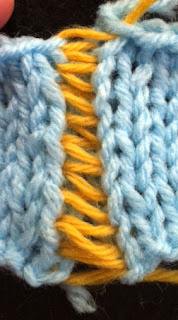If you want to add a little glitz to your tassels, why not use beads? It is really simple to do - the process is basically the same as making regular tassels, but you don't cut the bottom of the tassel. Just pick some beads appropriate for your yarn. If you aren't able to find beads that will fit your yarn, try using a complimentary, light weight yarn that the beads will fit on and wrap it along with the yarn used for the project. Or you can just use the different yarn by itself.
Like regular tassels, you will need something to wrap your yarn around that is the length you want the tassel to be. You also need beads of course, and scissors. You will also need a needle that will fit through the hole in your bead with the yarn, or you can use a crochet hook to put the beads onto your yarn like I do in the video.
You can use as many beads as you like. For the tassel above, I just kept one bead per strand as I wrapped. Once you are done wrapping, cut the yarn. You will need to cut another length of yarn to tie the tassel at the top so it doesn't fall apart. Then, just slid the tassel off the cardboard or whatever you wrapped it around. Do not cut the bottom of the tassel or your beads will come off. You can then tie another piece of yarn around the top of the tassel if you like. Attach the tassel to your project and trim any ends that may be sticking out.
Here is a video showing how I made the tassel above.










